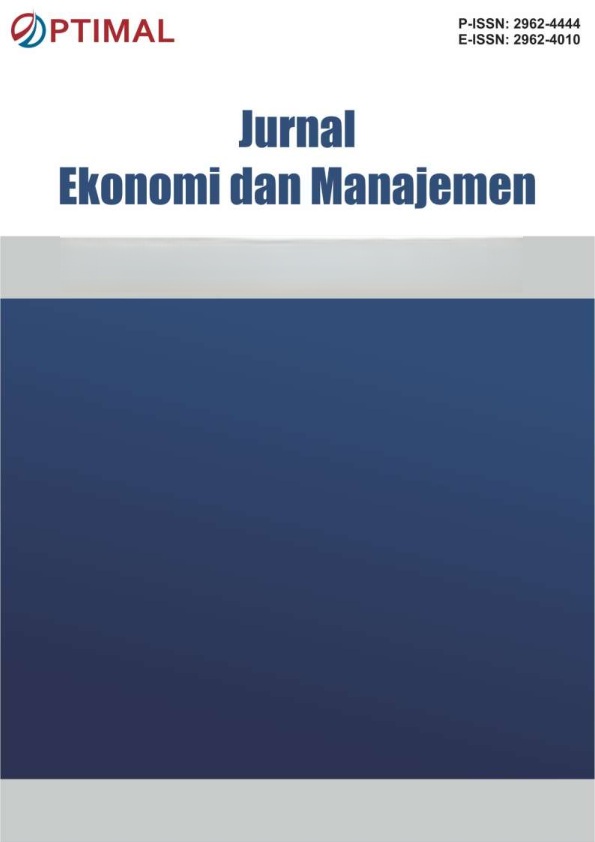Analisis Pengaruh Aliran Modal Internasional terhadap Devisa, Nilai Tukar, Pertumbuhan Ekonomi dan Inflasi
DOI:
https://doi.org/10.55606/optimal.v5i3.7367Keywords:
economic growth, exchange rate, foreign exchange reserves, Indonesia, inflation, international capital flow, VARAbstract
The globalization of financial markets has facilitated increased capital mobility across countries, making international capital flows a critical factor influencing macroeconomic stability in developing economies such as Indonesia. This study aims to analyze the impact of international capital flows—measured by net capital flow—on foreign exchange reserves, exchange rates, economic growth, and inflation in Indonesia. Using a quantitative associative approach, the study employs quarterly data from 2005 to 2022 obtained from credible institutional sources such as Bank Indonesia and the Central Bureau of Statistics. The analytical methods applied include Vector Autoregressive (VAR) and Vector Error Correction Model (VECM), supported by stationarity tests, cointegration analysis, Impulse Response Function (IRF), and Variance Decomposition (VD). The empirical results reveal four key findings. First, international capital flows have a significant long-term negative relationship with Indonesia's foreign exchange reserves, highlighting the importance of managing the quality and stability of capital inflows. Second, capital inflows contribute to the long-term appreciation of the rupiah, although this effect is not significant in the short term. Third, foreign capital inflows positively affect Indonesia's economic growth in both the short and long term, provided they are directed toward productive sectors. Lastly, capital inflows exhibit a deflationary effect in the long run, indicating their role in domestic price stabilization, though short-term impacts remain limited. These findings underscore the dual role of international capital flows as both a driver of economic development and a potential source of macroeconomic vulnerability, warranting prudent and adaptive policy responses.
References
Adnan, A., & Tedja, E. (2023). Vector error correction model in explaining the association of some macroeconomic variables in Indonesia. Jurnal Ekonomi Pembangunan, Manajemen & Bisnis, Akuntansi, 3(1), 1-13.
Agus Widarjono, 2007. Ekonometrika Teori dan Aplikasi untuk Ekonomi dan Bisnis, Edisi Kedua, Cetakan Kesatu, Penerbit Ekonisia Fakultas Ekonomi UII Yogyakarta.
Alawiyah, T., Haryadi, & Amzar, Y. V. (2019). Pengaruh Inflasi dan Jumlah Uang Beredar terhadap Nilai Tukar Rupiah dengan Pendekatan Model Struktural VAR. Journal Perdagangan Industri dan Moneter, 7(1), 2303–1204.
Ardiansyah, M. (2002). Impact of the 1997–1998 Asian financial crisis on the Indonesian and Malaysian palm oil and palm kernel oil industries. Oklahoma State University.
Arestis, M. and Glickman, M. (2002), “Financial Crises in Southeast Asia: Dispelling the Illusions the Minskyan Way”, Cambridge Journal of Economics, Vol.26, Num. 2, pp. 237-60.
Arief, Sritua. dan Adi Sasono. 1987. Modal Asing Beban Utang Luar Negeri dan Ekonomi Indonesia. Jakarta: Universitas Indonesia.
Aulia, D. G. R. (2020). FAKTOR-FAKTOR YANG MEMPENGARUHI NET CAPITAL INFLOWS DI INDONESIA (Doctoral dissertation, Universitas Hasanuddin).
Barro, R. J., & Sala-i-Martin, X. (2004). Economic Growth (2nd ed.). Cambridge, MA: MIT Press.
Bank Indonesia. (2020). Laporan Tahunan Bank Indonesia 2020. Jakarta: Bank Indonesia.
Basri, R., Yusuf, Y., & Rosyetti, R. (2017). Analisis Kausalitas antara Capital Inflow dan Nilai Tukar Rupiah di Indonesia Periode Tahun 2000-2015 (Doctoral dissertation, Riau University).
Boediono. 1995. Ekonomi Moneter Seri Sinopsis Pengantar Ilmu Ekonomi No. 5. Yogyakarta: BPFE.
Brooks, C. (2002). Introductory Economics for Finance. Cambridge-UK: Cambridge University Press.
Bustelo, P. (2004). Capital flows and financial crises: A comparative analysis of East Asia (1997-98) and Argentina (2001-02). Complutense University of Madrid Economics Working Paper, (2004-017).
Caporale, G. M., Ali, F. M., Spagnolo, F., & Spagnolo, N. (2017). International portfolio flows and exchange rate volatility in emerging Asian markets. Journal of International Money and Finance, 76, 1-15.
Christianingrum, R., & Syafri, R. A. (2019). Faktor-faktor yang memengaruhi inflasi inti di Indonesia. Jurnal Budget: Isu dan Masalah Keuangan Negara, 4(2), 18-39.
Edwards, S. (1999). How effective are capital controls?. Journal of Economic Perspectives, 13(4), 65-84.
Enders, W. (1995) Applied Econometric Time Series, John Wiley & Sons, New York.
Engle, R.F., and C.W.J. Granger., (1987). Co-integration and error correction: representation, estimation, and testing, Econometrica, vol. 55, No. 1, 251-276.
Ertruk, K. A. (2001), “Overcapacity and the Asian Financial Crisis”, Journal of
Fadhilah, J. N. (2022). Faktor-Faktor Yang Menyebabkan Melemahnya Nilai Tukar Mata Uang Rupiah Terhadap Nilai Tukar Mata Uang Asing. Jurnal Ekonomi Islam, 7(1), 135–144.
Fahmi, A. (2019). Pengaruh capital inflow, inflasi, suku bunga, ekspor, dan impor terhadap nilai tukar rupiah. Kinerja: Jurnal Ekonomi dan Manajemen, 16(1), 40-50.
Frisca, A., & Sitorus, N. H. (2019). Pengaruh Current Account dan Capital Inflow Terhadap Real Exchange Rate di Indonesia. In Prosiding Seminar Nasional Ilmu Sosial dan Teknologi (SNISTEK) (Vol. 2, pp. 43-48).
Gandhi, D. V. (2006). “Pengelolaan Cadangan Devisa di Bank Indonesia”. Jakarta:
Garg, R., Kim, S. H. & Swinnerton, E., 1999. The Asian Financial Crisis of 1997 and Its Consequences. Multinational Business Review, 7(2), pp. 32-36.
Gujarati, D. N. (2003). Basic Econometrics Fourth Edition. New York: Gary Burke.
Ifa, K., & Ardiansyah, F. (2019). Analisis Hubungan Foreign Direct Investment, Ekspor, Pengeluaran Pemerintah Dan Pertumbuhan Ekonomi Di Indonesia Menggunakan Vector Autoregression (Var). Journal Of Development Economic Issue, 2(1).
Ikhwan, R., & Ariusni, A. (2019). ANALISIS KAUSALITAS INVESTASI ASING LANGSUNG (FDI), EKSPOR DAN PERTUMBUHAN EKONOMI DI INDONESIA. Jurnal Kajian Ekonomi dan Pembangunan, 1(2), 383-392.
Indrawati, Y. (2012). Dampak Foreign Direct Investment dan Investasi Portofolio Terhadap Stabilitas Makroekonomi di Indonesia: Fenomena Global Imbalances. Prosiding Seminas Competitive Advantage, 1(2).
Jamaliah. 2018. Hubungan Kausalitas Pertumbuhan Ekonomi Dengan Investasi di Kota Pontianak Kajian Model Granger. Jurnal Ekonomi, Bisnis dan Kewirausahaan, Vol. 7 No. 1.
Juanda, B., dan Junaidi. (2012). Ekonometrika deret waktu teori dan aplikasi. Bogor (ID): IPB Press.
Juliodinata, A. I. (2017). Metode Vector Autoregressive dalam Menganalisis Pengaruh Kurs Mata Uang, Inflasi dan Suku Bunga Terhadap Indeks Harga Saham Gabungan (Doctoral dissertation, FMIPA).
Koepke, Robin. 2015. What Drives Capital Flows to Emerging Market? A Survey of the Empirical Literature. MPRA Paper No. 62770.
Krugman, P. R., & Obstfeld, M. (2009). International economics: Theory and policy sixth edition. New York : Pearson Education.
Kusmutiarani, A. W., Pranoto, Y. S., & Agustina, F. (2018). Dampak Fluktuasi Harga Tiga Komoditas Volatile Food Terhadap Inflasi di Kota Pangkalpinang. Jurnal Ekonomi Pertanian dan Agribisnis, 2(5), 364-377.
Mankiw, N. Gregory. 2007. Teori Makro Ekonomi Edisi Keempat. Jakarta: Erlangga.
Marcello, N., & Karmini, N. (2022). ANALISIS FAKTOR YANG MEMPENGARUHI NILAI TUKAR RUPIAH SEBELUM DAN SAAT GUNCANGAN MAKROEKONOMI. E-Jurnal Ekonomi Pembangunan Universitas Udayana, 11(12), 4331-4347
Mishkin, F. S. (2007). The Economics of Money, Banking, and Financial Markets. Eighth Edition. Pearson Education.
Muhnito, Meri Fita Sari. 2013. Identifikasi Sektor dan Subsektor Prioritas Dalam Pembangunan Provinsi Lampung. Lampung: Universitas Lampung.
Mulyaningsih, D. 2019. Pembangunan Ekonomi. Bandung : CV KIMFA MANDIRI.
Nizar, M. A. (2007). The Implications of the Capital Inflows on Indonesian Economy. Kajian Ekonomi Dan Keuangan, 11 (3), 130–155.
Panahi, O. P. (2016). The Asian Financial Crisis of 1997-1998 Revisited: Causes, Recovery, and the Path Going Forward.
Post-Keynesian Economics, Vol. 24, Num. 2, pp. 253-75.
Pusat Pendidikan dan Studi Kebanksentralan (PPSK).
Rangkuty, D. M., & Rusiadi, R. (2020). Fluktuasi Current Account Dan Portfolio Investment Terhadap Cadangan Devisa Indonesia. EKOMBIS: JURNAL FAKULTAS EKONOMI, 6(1).
RIDHO, M. A., & KOMARIYAH, S. (2020). Pengaruh Foreign Direct Investment, Portfolio Investment, Suku Bunga Terhadap Nilai Tukar DI Indonesia: Pendekatan Vector Error Correction Model (Vecm) (Doctoral dissertation, Program Studi Ekonomi Pembangunan Jurusan Ilmu Ekonom 2020).
Ruslan, D. (2015). Var Model Untuk Analisis Foreign Direct Investment Di Indonesia. Quantitative Economics Journal, 3(02).
Rusli, Muhammad Ilham. (2017). Analisis Pengaruh Suku Bunga, Inflasi, Dan Tingkat Pengembalian Modal Terhadap Investasi Properti Di Kota Makassar. UIN Alauddin Makassar.
Sugiyono. (2007). Metode Penelitian Kuantitatif, Kualitatif, dan R&D. Bandung: Alfabeta.
Sugiyono. (2017). Metode Penelitian Kuantitatif, Kualitatif, dan R&D. Bandung: Alfabeta.
Suhaidi, M., Anggraini, W., Novian, H., Nasor, M., & Sari, N. A. P. (2022). Hubungan Dinamis Arus Modal Asing, Nilai Tukar Rupiah dan Pergerakan Indeks JII 30 dengan Metode Pendekatan Vector Autoregressive (VAR) pada Masa Pandemi Covid 19. Jurnal Ilmiah Ekonomi Islam, 8(2),
Sukirno, Sadono. 2000. Makroekonomi Modern: Perkembangan Pemikiran Dari Klasik Hingga Keynesian Baru. Jakarta: Raja Grafindo Persada.
Suparmoko, M. 2013. Keuangan Negara. Yogyakarta: BPFE
Tambunan, TH. Tulus, (2001), “Transformasi Ekonomi di Indonesia, Teori & Penemuan Empiris”, Jakarta : Salemba empat.
Taylor, M. P., Sarno, L., & Franke, J. A. (2002). The Economics of Exchange Rates (1 ed., Vol. 1). Press Syndicate of the University of Cambridge.
Tjahjono, E. D., & Sulistiowati, H. (1998). Kebijakan Pengendalian Aliran Modal Masuk di Indonesia. Bulletin of Monetary Economics and Banking, 1(3), 187-212.
Van Wincoop, E., & Yi, K. M. (2004). Asia crisis postmortem 1: Where did the money go and did the United States benefit?. In The Korean Economy at the Crossroads (pp. 247-276). Routledge.
Wahab, Abdul. (2013). Ekonomi Internasional. Makassar : Alauddln University Press
Wahyuni, U., & Putri, D. Z. (2019). Pengaruh Arus Modal Masuk (Capital Inflow) Terhadap Perekonomian di Indonesia. Ecosains: Jurnal Ilmiah Ekonomi dan Pembangunan, 8(2), 109-120.
Warjiyo, P. (2016). Central Bank Policy Mix: Key Concepts and Indonesia’s Experience. Buletin Ekonomi Moneter dan Perbankan, 18(4), 379-408.
Warjiyo, Perry dan Solikin M. Juhro. 2017. Kebijakan Bank Sentral: Teori dan Praktik Ed. 1 Cet. 2. Depok: Rajawali Pers.
Widarjono, Agus. (2013). Ekonometrika Pengantar dan Aplikasinya. Edisi Keempat. Yogyakarta: UPP STIM YKPN
Zehri, C. (2020). Capital controls to manage foreign exchange reserves and foreign debts. Zbornik Radova Ekonomskog Fakulteta U Rijeci (Faculty of Economics and Business Rijeka), 38(1), 271-294.
Downloads
Published
How to Cite
Issue
Section
License
Copyright (c) 2025 OPTIMAL Jurnal Ekonomi dan Manajemen

This work is licensed under a Creative Commons Attribution-ShareAlike 4.0 International License.








